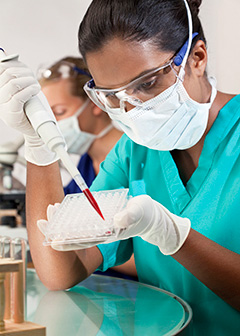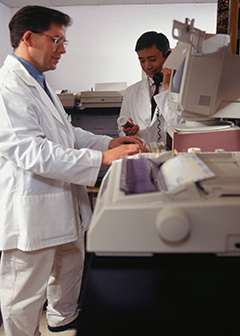
Most medical scientists have a Ph.D. in biology or a related life science.
Medical scientists typically need a Ph.D., usually in biology or a related life science, from an accredited postsecondary institution. Some medical scientists get a medical degree instead of a Ph.D. but prefer doing research to practicing as a physician. It is helpful for medical scientists to have both a Ph.D. and a medical degree.
Education
Students planning careers as medical scientists should pursue a bachelor's degree in a biological science. Undergraduate programs typically include courses in life sciences, as well as chemistry, physics, and mathematics. Humanities courses also are beneficial for developing writing and communication skills, which are necessary for drafting grant proposals and publishing research results.
After students have completed undergraduate studies, there are two main degree paths for prospective medical scientists: either a Ph.D. or a joint M.D.-Ph.D. Students can enroll in a university Ph.D. program in the biological sciences, which typically take about 6 years of study. Ph.D. students specialize in one particular field, such as genetics, pathology, or bioinformatics. For a joint M.D.-Ph.D. program, students enroll at a medical college that typically takes 7 to 8 years of study. Students learn both the clinical skills needed to be a physician and the research skills needed to be a scientist.
Graduate programs place additional emphasis on laboratory work and original research. These programs offer prospective medical scientists the opportunity to develop their experiments and, sometimes, to supervise undergraduates. A Ph.D. culminates in a thesis, which the candidate presents before a committee of professors.
Those who go to medical school spend most of the first 2 years in labs and classrooms, taking courses such as anatomy, biochemistry, physiology, pharmacology, psychology, microbiology, pathology, medical ethics, and medical law. They also learn to take medical histories, examine patients, and diagnose illnesses. For more information, see the profile on physicians and surgeons.
Medical scientists often continue their education with postdoctoral work at universities or with federal agencies, such as the National Institutes of Health. Postdoctoral work provides valuable lab experience, including in specific processes and techniques such as gene splicing, which is transferable to other research projects. In some institutions, the postdoctoral position leads to a permanent job.
Licenses
Medical scientists who administer drug or gene therapy to human patients, or who otherwise interact medically with patients—drawing blood, excising tissue, or performing other invasive procedures—must be licensed physicians. To be licensed, physicians must graduate from an accredited medical school, pass a licensing examination, and complete 1 to 7 years of graduate medical education.
Important Qualities
Communication skills. Communication is critical because medical scientists must be able to explain their conclusions. Also, communication skills are important when medical scientists write grant proposals, which are often required to continue their research.
Critical-thinking skills. Medical scientists must use their expertise to determine the best method for solving a specific research question.
Data-analysis skills. Medical scientists use statistical techniques so that they can properly quantify and analyze health research questions.
Decision-making skills. Medical scientists must use their expertise and experience to determine what research questions to ask, how best to investigate the questions, and what data to will best answer the questions.
Observation skills. Medical scientists conduct experiments that require precise observation of samples and other health data. Any mistake could lead to inconclusive results.









